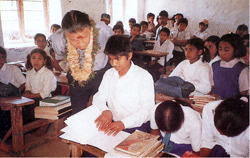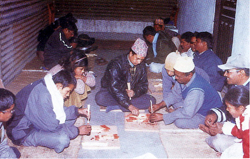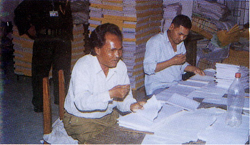A. REHABILITATION
1. Integrated Education:
|
|
(Photo: Teaching Learning Activities through Braille Script) |
- Education: NAWB is implementing integrated education program (IEP) for the blind in 89 schools covering 20 districts of Nepal where 389 blind students are currently getting education.
- Teachers Training: NAWB has been imparting training to teachers for special education. Till date, 21 B. Ed. level and 56 primary level teachers have been trained at Tribhuvan University in collaboration with Christoffel-Blindenmission & Special Education Council. After the close of Teachers Training Program in Tribhuvan University, NAWB is running specially designed 6 weeks Teachers Training Program since 1991. NAWB is also providing training to teachers, rehabilitation personals of different NGOs and office bearers of Special Education Department of HMG Nepal. To this day 125 persons have been provided 6 weeks Special Education Training.
2. Community Based Rehabilitation (CBR)
|
|
(Photo: Incense sticks Making Training) |
NAWB caters rehabilitation services at blinds' residence and at community level. NAWB has been running CBR program in 13 districts of Nepal. Community Based Rehabilitation (CBR) program is suitable for the developing country like Nepal. CBR is agro based, home based and community based program. Before starting CBR program in any place or district, a local co-operation committee is formed. A coordinator of the program and rehabilitation workers are selected and are imparted with intensive and extensive training for the execution of the program.
This program ensures that the blind persons are rehabilitated in the environs of their own community. Once the Blind and Visually Impaired persons are identified, they are divided into two groups: curable and incurable. Curable persons are referred to hospital and eye camps for treatment. Incurable BVI persons are registered for CBR and are categorized according to their age -
- Preschool children (Age below 6 years);
- School going children (6 to 15 years);
- Adults (16 to 45 years) and
- Elderly persons (above 45 years).
Suitable programs, such as Early Intervention Education, Orientation and Mobility, Vocational Training are developed by appropriately trained Rehabilitation
- Manual Dexterity Skills: Normally the hands of the dossile blinds are stiff. Through this skill their hands become flexible suitable to undergo for vocational Training.
- Vocational Training: Vocational training is provided to the active adult blind on the vocation available in their own community.
- Economic Rehabilitation: Interest free loans are provided to the blind person to start their own income generating activities.
- Follow up: Assessment of activities of BVI and secure loan repayment.
Job Placement
|
|
(Photo: BVI Persons Working at Factory) |
NAWB works as advocacy group and search the job by convincing the entrepreneurs that the Blind & Visually Impaired (BVI) persons are capable to work in factories. With the help of private entrepreneurs, NAWB, has been able to secure employment for BVI persons in different factories. The public sector has yet to come to rescue by creating employment to BVI persons.
Thanks to private entrepreneurs for extending employment opportunities to BVI. So far, at the best initiative of NAWB, 42 blind persons are currently employed in different industrial areas and their output record is above par.





